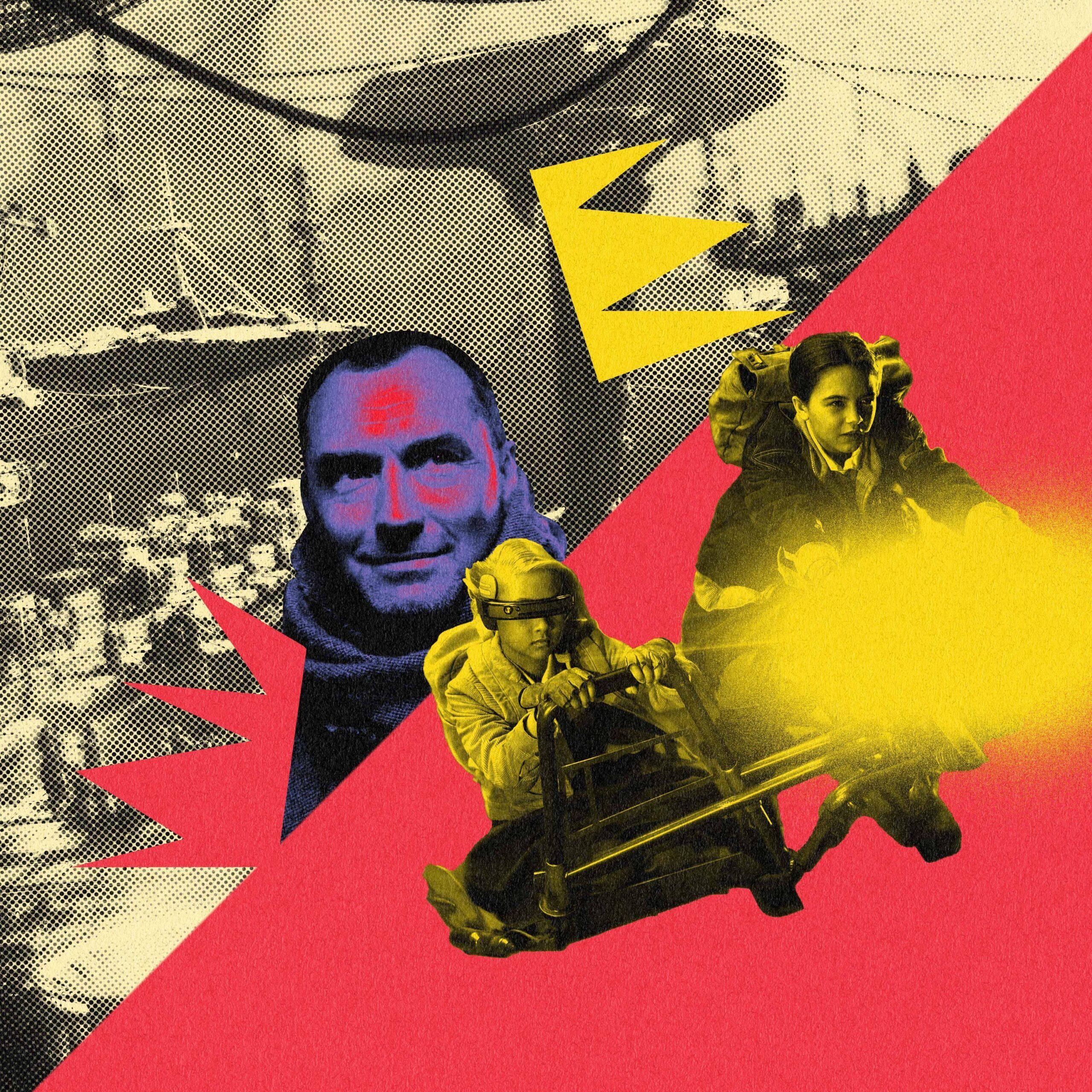

Star Wars: Skeleton Crew starts the same way Star Wars did: with a smaller ship being boarded by enforcers from a bigger, badder one. You’ve seen how this sequence plays out. The anxious good guys grip their blasters and wait for the hull to be breached. The villainous attackers storm in and quickly overrun the valiant but doomed defenders. Once the coast is clear, the armored, helmeted commander makes his grand entrance and holds the defiant, vanquished captain by the neck, briefly interrogating him about the nature of his mission before leaving him lifeless. The details are different in Skeleton Crew than they were in Episode IV—pirates instead of stormtroopers, someone named Silvo instead of Darth Vader, the crew of a freighter vs. the crew of a Rebel blockade runner masquerading as a consular ship—but the basic setup is the same. This is how Star Wars series tend to end or, in Skeleton Crew’s case, begin: by borrowing from the past.
If you’re sick of this sort of Star Wars recycling, I’ve got good news: First scene (and dozens of Easter eggs) notwithstanding, Skeleton Crew is a distinctive Star Wars adventure. The caveat is that Skeleton Crew carves out its unique corner inside Star Wars by taking its cues from another 1980s institution. The series is still an homage to the era that produced the Star Wars original trilogy—just not, first and foremost, to the trilogy itself. At this point, that passes for originality in Lucasfilm’s flagship franchise. And to Skeleton Crew’s credit, the melding of two decades-old traditions makes each one feel fresher than it would on its own. Sometimes, Star Wars seems painfully familiar. Skeleton Crew is familiar in a fun way.
Series cocreator Jon Watts, best known for directing the Marvel Cinematic Universe’s Spider-Man movies, sold Skeleton Crew as “[The] Goonies in Star Wars,” in the words of Lucasfilm president Kathleen Kennedy. Kennedy, a cofounder (with Steven Spielberg and Frank Marshall) of Goonies production company Amblin Entertainment, was unsurprisingly receptive to the pitch. Skeleton Crew delivers on that well-publicized premise, at times too faithfully but always with the earnestness, pluck, and dusting of danger that that subgenre requires.
All the thematic and material tropes of Amblin classics E.T. (1982) and The Goonies (1985), along with simpatico contemporaries such as Stand by Me (1986, but based on Stephen King’s 1982 novella The Body), are on display in the two-part premiere of Skeleton Crew, which went live on Disney+ on Monday night. We have latchkey kids, fractured families, and hidden treasures; practical effects, kids’ silhouettes, and the juxtaposition of all-ages antics and genuinely unsettling sights. Skeleton Crew replaces bicycles with broken-down speeders and walkie-talkies with, well, Star Wars walkie-talkies, but the formula suits the series’ long-ago and far, far away setting almost as comfortably as it fit the San Fernando Valley, the Goon Docks, or Castle Rock.
Like The Goonies and Stand by Me, Skeleton Crew focuses on a group of four kids, though it’s centered on one, Wim (Ravi Cabot-Conyers), who dreams of escaping the quartet’s seemingly mundane native planet, At Attin (pronounced the way some people say “AT-AT”—“at at”—plus “in”). While running late for the assessment test that could dictate his career, he literally stumbles across a mysterious hatch buried in the ground. After he, his habitually rule-following, elephantine friend Neel (Robert Timothy Smith), and their new acquaintances Fern (Ryan Kiera Armstrong) and KB (Kyriana Kratter) excavate further, they find a way to access the hatch, only to learn that it leads to a long-buried starship. With a furtive assist from Wim, the ship soon comes back to life like a living thing and carries the kids off planet and into hyperspace. Instead of helping a stranded interstellar voyager return home, à la Elliott from E.T., Skeleton Crew’s youngsters are trying to get home themselves, preferably by the end of an eight-episode season.
Crucially, the kids are all above-replacement-level actors. (Armstrong as Fern is especially strong.) The core cast also consists of salty pirate droid SM-33 (get it?), who’s voiced by the boisterous Nick Frost, and the mysterious, reticent, possibly Force-sensitive stranger Jod Na Nawood (played by Jude Law, who enlivens the proceedings as soon as he shows up at the end of Episode 2). Some of the series’ designs seem reverse engineered to provide Walt Disney Imagineering with fodder for a future Rise of the Resistance–esque dark ride or installment of Star Tours, but some set pieces are impressive, and the directors are a pedigreed group whose credits include blockbusters, critical darlings, and Stars Wars credits among them: Watts himself, David Lowery (The Green Knight), Lee Isaac Chung (Minari, Twisters), Bryce Dallas Howard (The Mandalorian, The Book of Boba Fett), the Daniels (Everything Everywhere All at Once), and Jake Schreier (the forthcoming Thunderbolts).
“Is Star Wars for children?,” the second-greatest thread in the history of forums, was recently reopened by director Denis Villeneuve, who confessed to swearing off Star Wars after Return of the Jedi turned out to be “a comedy for kids.” Villeneuve, who still seems upset about this perceived betrayal—“Still today, the Ewoks,” he fumed—also lamented that the franchise “became crystalized in its own mythology, very dogmatic. It seemed like a recipe, no more surprises.”
He’s quite right to raise the latter critique. Skeleton Crew arrives at a tough time in terms of the franchise’s recent track record and perceived direction. Lucasfilm hasn’t had an unqualified win from a quality standpoint since Andor debuted more than two years ago, and even Andor wasn’t a popular smash by Star Wars standards. The Acolyte, the only other live-action Star Wars release of 2024—and one that was envisioned as a mold-breaking departure from Star Wars as usual—failed to earn an audience large enough to justify its budget and was canceled. Star Wars moviemaking remains in disarray, with only one film—The Mandalorian & Grogu, ported from TV—officially scheduled for release, in May 2026. “The closet is a little bare,” one source told The Hollywood Reporter last month, with another adding, “Star Wars is a nostalgia-based enterprise, and they are running out of ways to create nostalgia.”
Amid these difficulties, Skeleton Crew would be ill cast as a savior. Does this mash-up of cultural touchstones seem essential, to the extent that any Star Wars story does? Is it likely to garner great Nielsen ratings or change the perception of Star Wars as a floundering franchise (despite its numerous successes during the Disney era)? Is it bold, boundary breaking, strikingly creative? We can confidently answer “Eh” to all of the above.
It’s easier to counter the complaint about catering to kids. Shortly before Andor debuted, I traced the history of debates about the target audience for Star Wars. In 1999, George Lucas claimed, “The movies are for children,” and in 2017, he called the original Star Wars “a film for 12-year-olds.” But his most telling appraisal comes from 1977, when he said, “It’s not a silly child’s film” and noted, “It’s not playing down to people, but it is still an entertaining movie and doesn’t have a lot of violence and sex and hip new stuff. … It still has a vision to it, a sort of wholesome, honest vision about the way you want the world to be.” In other words, it was for kids—of course it was—but not exclusively. When it’s working well, Star Wars is the epitome of a four-quadrant IP—and not in a pandering, watered-down way, where it’s so obviously engineered to appeal to everyone that it doesn’t really resonate with anyone. Though it probably helps to have started young.
So yes, on-screen Star Wars has always been digestible by kids. However, it hasn’t really been about kids to the degree of Skeleton Crew (except, say, Young Jedi Adventures). If that lowers its ceiling, so be it; they can’t all be Andor. I don’t mind a dose of low-ceiling, low-stakes Star Wars, as long as I’m entertained.
If Skeleton Crew gives any viewers the impression of a deeper import than it appears to possess thus far, it would probably be because of when it’s set. The series, which is executive-produced by Jon Favreau and Dave Filoni, is technically part of the Mandoverse, and it takes place in the post-Imperial period also occupied by The Mandalorian, The Book of Boba Fett, and Ahsoka. In the early going, there’s scant connective tissue between that trio and this series, aside from its continued emphasis on how overextended the New Republic is—hence the profusion of pirates—and the low-profile presence of a minor character from the third season of The Mandalorian, the self-preserving pirate Vane.
On another level, though, Skeleton Crew boasts intriguing ties to Star Wars lore. At first, At Attin seems noteworthy mostly because it gives us our first live-action look at Star Wars suburbs. But it soon becomes clear that the planet isn’t what it seems. First, there’s Win’s Jedi fixation, which seems somewhat anachronistic decades after Order 66. (In The Mandalorian and later tales, the Jedi are the stuff of legends, if they’re remembered at all; Emperor Palpatine and Vader did their work well.) Second, there’s Undersecretary Fara’s reference to the “Great Work” of “keeping the Republic peaceful and safe”—reminiscent of the Great Works the Old Republic undertook during the High Republic era. Third, there’s the “Barrier” that envelops the planet, visible from the ground as an opaque cloud layer whose whorls are punctuated by bright red dots. Fourth, there’s Wim’s pristine set of Old Republic credits, or dataries, a routine gift from his father. Throw in outmoded slang (wizard!) and archaic-looking fashion and technology—in class, Wim draws a Jedi on what looks like a digital Etch A Sketch—and the clear implication is that At Attin is a time-capsule planet from the pre-Imperial age.
This narrative sleight of hand, which subtly reframes which “Republic” the characters are referring to, is a good trick. Not only does it add At Attin to a list in Star Wars lore of “hidden” planets protected by nebulae, from Exegol to the Maw Cluster to Tanalorr, but it also sets up opportunities and poses questions. How and why was At Attin sealed off? What kind of culture shock will ensue if and when its populace learns about the decades or centuries of galactic turmoil it just sat out? And if At Attin is actually “the lost planet of eternal treasure,” what’s the treasure (aside from the friends the kids made along the way)?
Add it all up, and the show about kids, and to some extent for them, arguably boasts more compelling mysteries than The Acolyte, which was ostensibly a mystery show for a more mature audience. After two episodes, maybe there’s more to the treasure, and to the series’ lone lead adult, than is dreamt of in our philosophies. “Can you keep a secret?” Nawood asks the kids at the end of the second installment. One gets the sense that he can, and that this superficially simple series can, too.
As of now, though, one secret is out: Skeleton Crew is worth watching, although it’s not necessarily worth proclaiming that Star Wars is so back. The recipe Skeleton Crew follows isn’t just four decades old in its original flavor; it’s also already been mined for nostalgia more recently, from Super 8 to Stranger Things. But it’s nice to know that Westerns and samurai movies aren’t the only influences that Star Wars can incorporate. Maybe it’s a sign of strength that Star Wars can assimilate so many other strains of storytelling—Andor’s political realism, The Acolyte’s wuxia-style combat—with some degree of success. Maybe it’s more like evidence of an identity crisis. But the seamless fusion of fondly remembered beats in the first few episodes of Skeleton Crew suggests that the series could be, if not an eternal treasure, then at least a short-term treasure—one that could tide us over until April, when Andor is set to return to scratch a very different sort of Star Wars itch and delight a different demographic.



